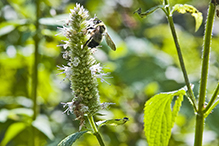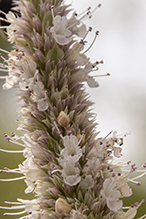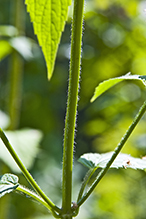purple giant hyssop
(Agastache scrophulariifolia)
Conservation • Description • Habitat • Ecology • Use • Distribution • Taxonomy
|
|
||||||||||||||
Description |
Purple giant hyssop is a 36″ to 60″ tall, erect, late-flowering perennial forb that rises from a rhizome. The stems are erect, obtusely 4-angled, diamond-shaped in cross section, and branched above the middle. They are usually tinged purple. They have a sparse to dense covering of short, soft, downward-curved hairs along the ridges. The leaves are opposite, mostly thin, egg-shaped to oblong egg-shaped, 2″ to 5″ long, and up to 2″ wide. Lower leaves are on leaf stalks up to 2″ long. The leaf stalks are usually covered with short, soft hairs, sometimes covered with long, soft, shaggy, unmatted hairs. The leaves become only slightly smaller and the leaf stalks only slightly shorter as they ascend the stem. Lower leaf blades are rounded to almost heart-shaped at the base and tapered to a point at the tip with straight or concave sides along the tip. Upper leaf blades are tapered at the base. The upper leaf surface is green and either hairless or covered with short, soft hairs. The lower surface is green, not white, and may be hairless or covered with long, soft, shaggy, unmatted hairs. The margins are coarsely toothed with sharp, forward-pointing teeth. The leaves emit a strong, anise-like odor when crushed. The inflorescence is a dense spike at the end of the stems and branches. The spikes are usually continuous, sometimes interrupted, up to 6″ long, and ⅝″ to ¾″ wide, including the corollas. The flowers are arranged in dense whorls that are subtended by hairless, broadly egg-shaped, abruptly tapered, inconspicuous bracts. The individual flowers are about ½″ long. There are 5 green sepals fused onto a ¼″ to ⅜″ long calyx tube with 5 lance-shaped or triangular lobes. The calyx is hairless. There are 5 petals fused into a funnel-shaped corolla tube with a 2-lobed upper lip and a 3-lobed lower lip. The corolla is often white, sometimes pale pink to purple, and extends well beyond the calyx. There are 4 stamens with purple anthers that protrude well beyond the corolla. The sepals that remain on the spike after the corollas have dropped off are green or whitish, not purple. The fruit is a more or less 3-sided nutlet. |
Height |
36″ to 60″ |
Flower Color |
White or pale pink to purple |
Similar Species |
Blue giant hyssop (Agastache foeniculum) is a much shorter plant, reaching only 36″ in height at maturity. The underside of the leaf is whitish due to a covering of microscopic white hairs. The flowers are blue. The sepals that remain on the spike after the corollas have dropped off are purple. |
Habitat |
Dry. Upland woods and thickets. Partial sunlight. |
Ecology |
Flowering |
August to September |
Pests and Diseases |
|
Use |
|
Distribution |
||
|
Sources |
|
| 9/4/2024 | ||
Nativity |
||
Native |
||
Occurrence |
||
|
||
Taxonomy |
|
Kingdom |
|
Division |
Tracheophyta (Vascular Plants) |
Subdivision |
Spermatophytina (Seed Plants) |
Class |
|
Order |
Lamiales (Mints, Plantains, Olives, and Allies) |
Family |
Lamiaceae (Mint) |
Subfamily |
Nepetoideae |
Tribe |
Mentheae |
Subtribe |
Nepetinae (catmints, ground ivies, and hyssops) |
Genus |
Agastache (hyssops) |
Subordinate Taxa |
|
|
|
Synonyms |
|
Agastache scrophulariifolia var. mollis Lophanthus scrophulariaefolius |
|
Common Names |
|
figwort giant-hyssop purple giant hyssop purple giant-hyssop |
|
Glossary
Bract
Modified leaf at the base of a flower stalk, flower cluster, or inflorescence.
Calyx
The group of outer floral leaves (sepals) below the petals, occasionally forming a tube.
Corolla
A collective name for all of the petals of a flower.
Rhizome
A horizontal, usually underground stem. It serves as a reproductive structure, producing roots below and shoots above at the nodes.
Visitor Photos |
||
Share your photo of this plant. |
||
This button not working for you? |
||
Greg Watson |
 |
Purple Giant Hyssop flowering on the trail. |
MinnesotaSeasons.com Photos |
||
 |
 |
|
Plant |
Plant |
|
 |
 |
|
Inflorescence |
Inflorescence |
|
 |
 |
|
Inflorescence |
||
|
||
|
||
|
Inflorescence |
|
 |
 |
|
Flowers |
Flowers |
|
 |
||
Flowers |
|
|
 |
 |
|
Leaves |
||
|
||
|
||
|
Leaves |
|
 |
 |
|
Stem |
Stem |
|
 |
 |
|
Stem |
Stem |

Slideshows |
|

Visitor Videos |
||
Share your video of this plant. |
||
This button not working for you? |
||
|
Other Videos |
||
Plant 27 |
About
Published on Aug 20, 2012 This looks like it may be a Agastache scrophulariifolia. I'm not sure though. |

Visitor Sightings |
||
Report a sighting of this plant. |
||
This button not working for you? |
||
Greg Watson |
Location: Root River State Trail - Lanesboro to Whalan Purple Giant Hyssop flowering on the trail. |
 |
MinnesotaSeasons.com Sightings |
||

|
Created: Last Updated: © MinnesotaSeasons.com. All rights reserved. |
